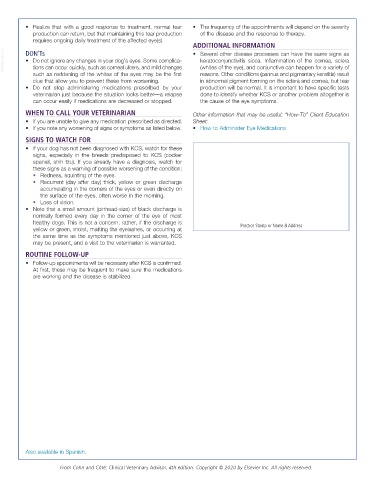Page 3053 - Cote clinical veterinary advisor dogs and cats 4th
P. 3053
• Realize that with a good response to treatment, normal tear • The frequency of the appointments will depend on the severity
production can return, but that maintaining this tear production of the disease and the response to therapy.
requires ongoing daily treatment of the affected eye(s).
ADDITIONAL INFORMATION
VetBooks.ir DON’Ts • Several other disease processes can have the same signs as
• Do not ignore any changes in your dog’s eyes. Some complica-
keratoconjunctivitis sicca. Inflammation of the cornea, sclera
tions can occur quickly, such as corneal ulcers, and mild changes
(whites of the eye), and conjunctiva can happen for a variety of
such as reddening of the whites of the eyes may be the first reasons. Other conditions (pannus and pigmentary keratitis) result
clue that allow you to prevent these from worsening. in abnormal pigment forming on the sclera and cornea, but tear
• Do not stop administering medications prescribed by your production will be normal. It is important to have specific tests
veterinarian just because the situation looks better—a relapse done to identify whether KCS or another problem altogether is
can occur easily if medications are decreased or stopped. the cause of the eye symptoms.
WHEN TO CALL YOUR VETERINARIAN Other information that may be useful: “How-To” Client Education
• If you are unable to give any medication prescribed as directed. Sheet:
• If you note any worsening of signs or symptoms as listed below. • How to Administer Eye Medications
SIGNS TO WATCH FOR
• If your dog has not been diagnosed with KCS, watch for these
signs, especially in the breeds predisposed to KCS (cocker
spaniel, shih tzu). If you already have a diagnosis, watch for
these signs as a warning of possible worsening of the condition:
• Redness, squinting of the eyes.
• Recurrent (day after day) thick, yellow or green discharge
accumulating in the corners of the eyes or even directly on
the surface of the eyes, often worse in the morning.
• Loss of vision.
• Note that a small amount (pinhead-size) of black discharge is
normally formed every day in the corner of the eye of most
healthy dogs. This is not a concern; rather, if the discharge is
yellow or green, moist, matting the eyelashes, or occurring at Practice Stamp or Name & Address
the same time as the symptoms mentioned just above, KCS
may be present, and a visit to the veterinarian is warranted.
ROUTINE FOLLOW-UP
• Follow-up appointments will be necessary after KCS is confirmed.
At first, these may be frequent to make sure the medications
are working and the disease is stabilized.
Also available in Spanish.
From Cohn and Côté: Clinical Veterinary Advisor, 4th edition. Copyright © 2020 by Elsevier Inc. All rights reserved.

